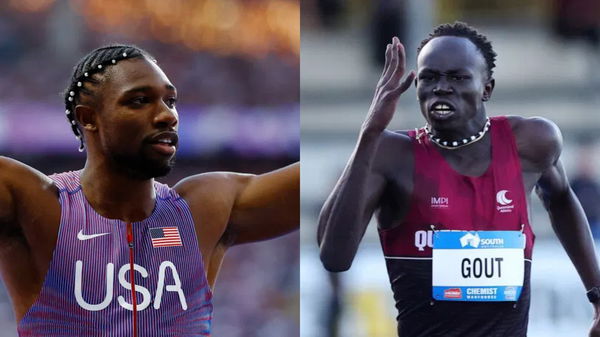
via Imago
credits: imago

via Imago
credits: imago
“I’m coming for that spot! I will do it!” That’s what Gout Gout confidently told Noah Lyles, throwing down the gauntlet like a true challenger. But here’s the twist—now it looks like Gout isn’t just chasing Lyles, he’s turning into him. Lyles is known for his slow starts with insane finishing speed in the 200m. And Gout seems to be following the same pattern, at least his recent sprint says so. The 17-year-old Australian sensation, who has been the country’s fastest man for a year now, just hit a major bump in the road at the worst possible moment.
On March 29 a the Maurie Plant Meet in Melbourne, Gout’s unbeaten streak finally came to a screeching halt. The hype was real—first sold-out crowd for an Aussie one-day meet since 2001, and all eyes were glued to Gout. He even made a rockstar entrance, strutting onto the track in a flashy red Adidas tracksuit, ready to put on a show. But instead of fireworks, we got a plot twist when 21-year-old Lachlan Kennedy stole the spotlight with a 20.26-second personal best to win the Peter Norman Memorial 200m. After his win, even Kennd said that “his goal was just to hold him [Gout] off.” And Gout? Well, the 17-year-old, despite turning on the jets in the final stretch, came up just short at 20.30 seconds. But it did not end there.
Gutted by the defeat, Gout confessed his true feelings. “People will say, winning feels great, second is bad. And today feels even worse,” he admitted, clearly feeling the sting. But here’s where it gets wild—Gout’s closing speed was insane. He was eating up the track in those last 100 meters and almost caught Kennedy at the line. But that slow start? It left him with just a bit too much ground to cover. Even Kennedy admitted afterward, “A few more meters, and Gout would’ve had me.” But the good news?
ADVERTISEMENT
Article continues below this ad

Gout’s already fired up. “So, coming second is something you can experience, and it definitely puts fuel to the fire and it lights that burn,” he said, eyes already locked on redemption. “So when I get into training, [I’ll] work even harder and be better for nationals. My closing speed is my gift, so it’s definitely just about building my first 100.” He knows exactly where the problem is—his start—and he’s ready to fix it.
But here’s where it gets juicy—this is exactly the same struggle Olympic gold medalist Noah Lyles had. Slow out of the blocks but a monster in the final stretch. Sound familiar? Lyles hasn’t completely nailed it, but he’s definitely figured out how to manage it. So now the real question is—what’s Lyles’ secret sauce? And more importantly, can Gout borrow a page from that playbook to take his game to the next level?
What’s your perspective on:
Is Gout Gout the future of sprinting, or is Noah Lyles still the king of the track?
Have an interesting take?
Noah Lyles and Gout are closer than you think on the track
Noah Lyles has always been that guy with jaw-dropping top-end speed, but those first 100 meters? Eh, not quite his sweet spot—at least not back in the day. Take the 2022 World Athletics Championships, for example. Lyles hit 10.15 seconds through the first 100 meters before flipping the switch and tearing through the second half in 9.16 seconds, finishing in a blazing 19.31. But even after grabbing gold, Lyles wasn’t satisfied. He knew if he could clean up that first half, he’d be even more dangerous. So, he got to work.
And when Noah Lyles decides to fix something, he doesn’t mess around. He hit the gym hard, building the strength needed for more explosive starts. Then, he fine-tuned his technique—quicker steps, less time on the ground, all the little details. To keep things on point, he even used white tape on the track so he could literally see where his feet needed to land. But the real game-changer?
ADVERTISEMENT
Article continues below this ad

Ralph Mann, the biomechanics guru who helped Lyles put it all together. By June 2023, at the Paris Diamond League, Lyles was already showing off the results, blazing through 60 meters in 6.55 seconds and winning in 9.97. By the time he lined up in Paris, Lyles wasn’t just fast—he was complete.
ADVERTISEMENT
Article continues below this ad
And we know, back in January, Gout was seen training with Lyles and his coach, Lance Brauman, which means he’s learning from the best. If Gout keeps this pace up, he might just be the next big thing in sprinting. Noah Lyles shares a similar track talent level with Gout despite their age difference of ten years. The huge age difference between Lyles, who is 27 years old, and Gou,t who is 17 years old, does not translate into a speed gap on the track.
Noah Lyles hits a personal best in the 100-meter dash at 9.79 seconds while Gout maintains a time of 10.04 seconds just behind him.. Over 200m? Lyles dominates with 19.31, but Gout’s 20.04 smashed a 56-year-old Australian record. And here’s where it gets wild: in the 400m, Gout clocked 46.20, leaving Lyles’ 47.04 looking like yesterday’s news. The kid’s coming, and he’s coming fast.
ADVERTISEMENT
ADVERTISEMENT
ADVERTISEMENT
ADVERTISEMENT


Is Gout Gout the future of sprinting, or is Noah Lyles still the king of the track?